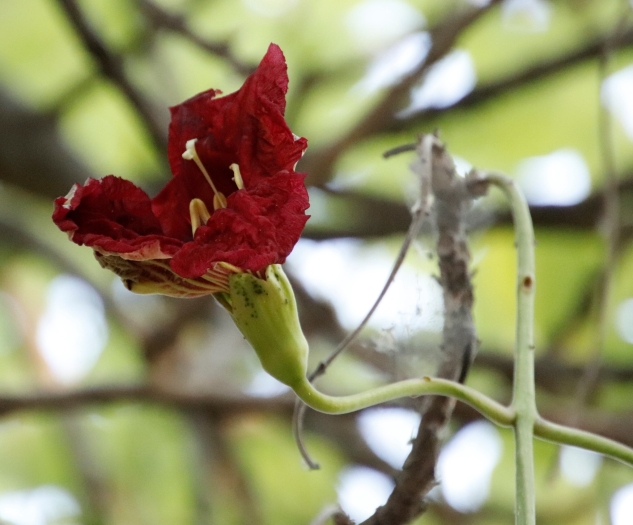Sausage Tree
(Kigelia africana)
Sausage Tree (Kigelia africana)
/
/

Tony Rebelo
CC BY-SA 4.0
Image By:
Tony Rebelo
Recorded By:
Copyright:
CC BY-SA 4.0
Copyright Notice:
Photo by: Tony Rebelo | License Type: CC BY-SA 4.0 | License URL: http://creativecommons.org/licenses/by-sa/4.0/ | Rights Holder: Tony Rebelo | Publisher: iNaturalist | Date Created: 2022-08-22T07:49:18-07:00 |






















Estimated Native Range
Summary
Kigelia africana, commonly known as the sausage tree, is a deciduous tree native to open woodlands and savanna regions across tropical Africa. It can grow up to 66 feet tall with a spreading canopy that provides shade. The tree is known for its striking, large, sausage-shaped fruits that can be up to 24 inches long and weigh around 7 kg. The flowers of Kigelia africana are maroon, bell-shaped, and hang in long panicles; they are pollinated primarily by bats and large insects during the night. Flowering typically occurs when the tree is leafless, which enhances the visibility of the flowers to pollinators.
The sausage tree is valued for its unique ornamental fruits and attractive, showy flowers. It is used in large gardens and public landscapes for its dramatic appearance and shade-providing canopy. Kigelia africana prefers full sun to light shade and grows best in well-drained soils. It is drought-tolerant once established, making it suitable for xeriscaping in suitable climates. The tree has traditional medicinal uses, and its fruits are sometimes used in skin care products. However, caution is advised as the raw fruit is poisonous if ingested. Kigelia africana can be potentially invasive in some non-native regions, so it is important to check local regulations before planting.CC BY-SA 4.0
The sausage tree is valued for its unique ornamental fruits and attractive, showy flowers. It is used in large gardens and public landscapes for its dramatic appearance and shade-providing canopy. Kigelia africana prefers full sun to light shade and grows best in well-drained soils. It is drought-tolerant once established, making it suitable for xeriscaping in suitable climates. The tree has traditional medicinal uses, and its fruits are sometimes used in skin care products. However, caution is advised as the raw fruit is poisonous if ingested. Kigelia africana can be potentially invasive in some non-native regions, so it is important to check local regulations before planting.CC BY-SA 4.0
Plant Description
- Plant Type: Tree
- Height: 15-60 feet
- Width: 15-40 feet
- Growth Rate: Moderate
- Flower Color: Red
- Flowering Season: Spring, Summer, Fall
- Leaf Retention: Evergreen, Semi-deciduous
Growth Requirements
- Sun: Full Sun
- Water: Medium
- Drainage: Medium, Fast
Common Uses
Bird Garden, Butterfly Garden, Showy Flowers
Natural Habitat
Native to open woodlands and savanna regions across tropical Africa
Other Names
Common Names: Cucumber Tree, African Sausage Tree, Mfunguti, Muungutwa, Mvunguti
Scientific Names: , Kigelia africana, Kigelia ikbaliae,
GBIF Accepted Name: